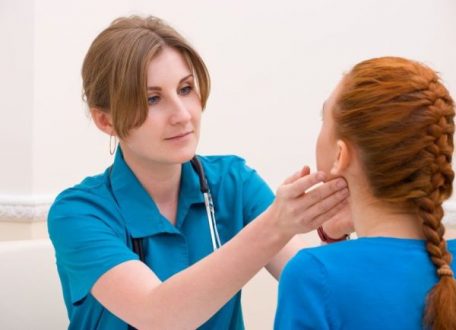Primary herpetic gingivostomatitis is an oral cavity infection caused by the herpes virus. It is the type of herpes gingivostomatitis that occurs in children. Symptoms include swallowing difficulty, increased salivation, submandibular lymphadenopathy, and oral and perioral ulcers.
The virus that causes primary herpetic gingivostomatitis is herpes simplex virus type 1. The virus enters the body by sensory and autonomic neurons, where it becomes latent HSV in the neural ganglia. Primary herpetic gingivostomatitis emerges as a broad, erythematous, shiny gingival and surrounding oral mucosa involvement with different degrees of edema and gingival hemorrhage.
The initial presentation of the virus is spherical clustered vesicles. It appears on the tongue, pharynx, sublingual mucosa, buccal mucosa, gingivial, labial, and soft palate. The vesicles break 24 hours later, forming painful tiny ulcers with a red, raised halo-like edge and a depressed, yellowish, or greyish white core section.
Once a patient has been infected with the herpes simplex virus, the infection can reoccur as herpes labialis, with occasional reactivation throughout life.
Treatment with antiviral drugs can change the progression of the disease by lowering symptoms and potentially minimizing recurrences if caught early. Gingivostomatitis caused by primary herpes is infectious.
Primary Herpetic Gingivostomatitis Symptoms
Fever, malaise, and cervical lymphadenopathy are the most common systemic signs, followed by the formation of vesicles that proceed to ulcers. The acute phase lasts 7 to 10 days, and the lesions heal spontaneously in 1 to 2 weeks. Children the age of 6 months to 6 years tend to form these primary herpetic gingivostomatitis.
The symptom that is of major concern specifically in younger patients is dehydration. The younger patients find it difficult to eat or drink and as a result, they become dehydrated which can be a consequence of this viral infection.
Primary herpetic gingivostomatitis has non-specific prodromal symptoms that are dehydration, lack of appetite, fever, etc. It is important to diagnose the disease at the initial stage before it becomes fatal.
Primary Herpetic Gingivostomatitis Causes
The following are the causes of this primary herpetic gingivostomatitis :
- DNA herpes simplex virus (HSV) with HSV type 1.
- Mucous membranes and skin infections.
- Genital infections.
- Mild pharyngitis.
- innocuous labial lesions
There is an incubation period of 1 to 26 days, after which there are symptoms like malaise, anorexia, nausea, and irritability. Then there are a lot of characteristic oral vesicles, which are the cause. The vesicles easily rupture, producing jagged, painful sores hidden beneath a yellow-grey pseudomembrane.
The virus is spread by direct contact with a lesion or infected body fluids (e.g., saliva), and it most commonly affects children aged 2 to 5 years old as PHGS. Due to the lack of passive immunity, a young infant can get HSV-1.
Primary Herpetic Gingivostomatitis Treatment
The duration and severity of symptoms of PHGS are self-limiting; however, antiviral medication may shorten the duration and intensity of symptoms. The current treatment for this acute infection is oral acyclovir suspension, however, the optimal timing and dose of this therapy are unknown. Supportive care aims to reduce problems, and in this case, the use of a lip barrier cream would have prevented labial adhesions.
One of the treatments for PHGT is an outpatient treatment which includes the following management:
- Intensive oral hydration.
- Analgesics.
- Topical and systemic antiviral medication.
Severe disease that is resistant to treatment could indicate an underlying cause of immunosuppression, necessitating additional testing for recurrent, persistent, or refractory disease. In these severe cases, it becomes essential to treat the disease immediately after the diagnosis.
Patients frequently seek advice from their GDP, who will provide supportive care, such as maintaining fluid intake to avoid dehydration; analgesics and antipyretics to relieve fever and discomfort; and other medications as needed.
The treatment that is not usually practiced in this era is the use of a lip barrier cream to avoid lip adhesion, pain, and bleeding that can result from their separation. Hence the treatments mentioned above are considered best for the management of primary herpetic gingivostomatitis.
Gingivostomatitis rarely leads to major health complications, especially when treated early. However, it can be extremely unpleasant. Gingivostomatitis patients should improve their dental hygiene practices to avoid other health issues such as periodontal disease.
To lower the risk of gingivostomatitis, the following should be done:
- Maintain proper dental hygiene.
- Attend dental cleanings and check-ups regularly.
- Clean any oral appliances, such as dentures or retainers, regularly.
- Avoid close physical contact with infected people to lower the risk of contracting HSV-1.
 Health & Care Information
Health & Care Information 


